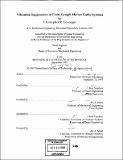Vibration suppression in finite length marine cable systems
Author(s)
Levesque, Christopher R. (Chirstopher Robert), 1965-
DownloadFull printable version (7.247Mb)
Advisor
J. Kim Vandiver.
Terms of use
Metadata
Show full item recordAbstract
The vibration suppression effectiveness of a flexible in-line marine cable vibration absorber is studied. The transfer matrix method is used to build various numerical models of vibration absorbers in marine cable systems. The models determine cable system natural frequencies, mode shapes and modal damping ratios. The introduction of absorber damping is shown to result in complex roots to the modal characteristic equations. A computer complex root solver is used to solve for the complex roots of the characteristic equations, resulting in complex system natural frequencies. The significance of complex natural frequencies is explained. Complex natural frequencies are used to calculate modal damping ratios. The models demonstrate that absorber effectiveness is heavily dependent on absorber location, absorber mass and absorber length. Parametric variation is used to achieve maximum effectiveness of the flexible in-line absorber. Even under optimum conditions, it is shown that the absorber provides insufficient damping to reduce vortexinduced vibrations in water. The same transfer matrix method is used to evaluate the effectiveness of a massspring- dashpot type absorber in a marine cable system. This type of absorber is shown to produce adequate damping to reduce vortex-induced vibrations in water. The transfer matrix method used in this thesis is validated by analyzing the same system using an approach by Den Hartog [1]. The transfer matrix approach combined with complex root solving capability is shown to provide an effective analysis method for marine cable systems.
Description
Thesis (Nav.E.)--Massachusetts Institute of Technology, Dept. of Ocean Engineering; and, (M.S.)--Massachusetts Institute of Technology, Dept. of Mechanical Engineering, 1998. Includes bibliographical references (p. 49).
Date issued
1998Department
Massachusetts Institute of Technology. Department of Ocean Engineering; Massachusetts Institute of Technology. Department of Mechanical EngineeringPublisher
Massachusetts Institute of Technology
Keywords
Ocean Engineering, Mechanical Engineering